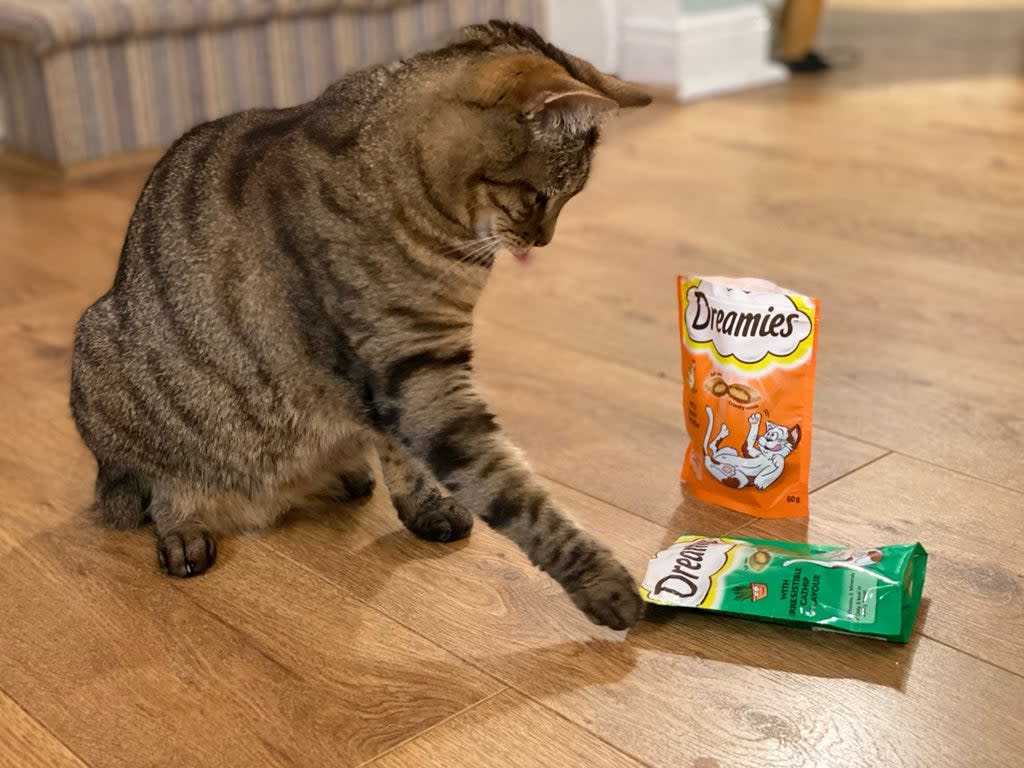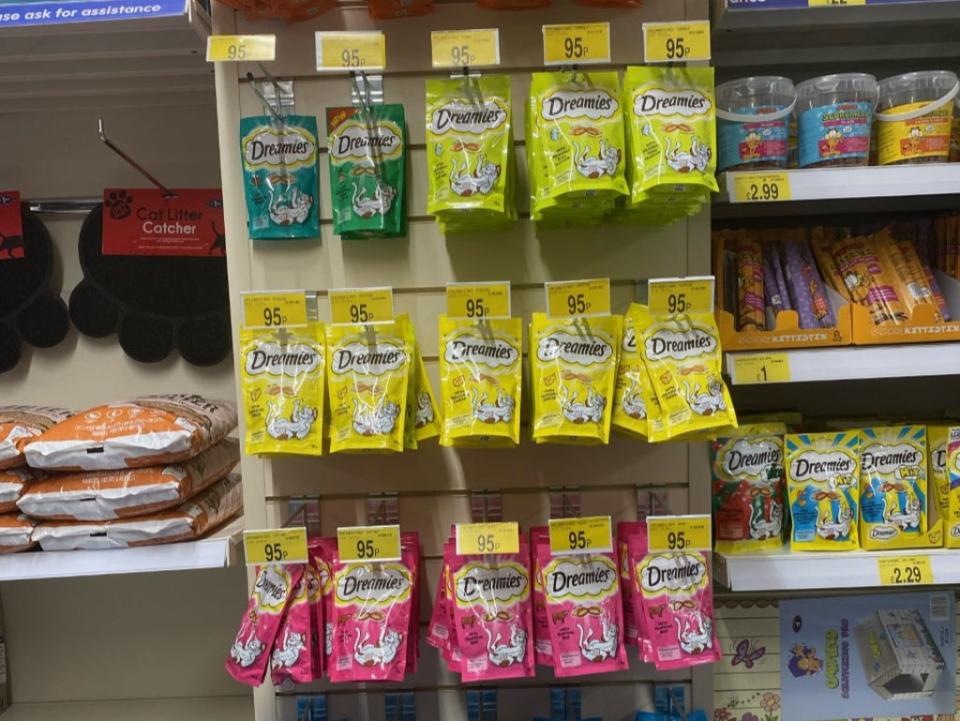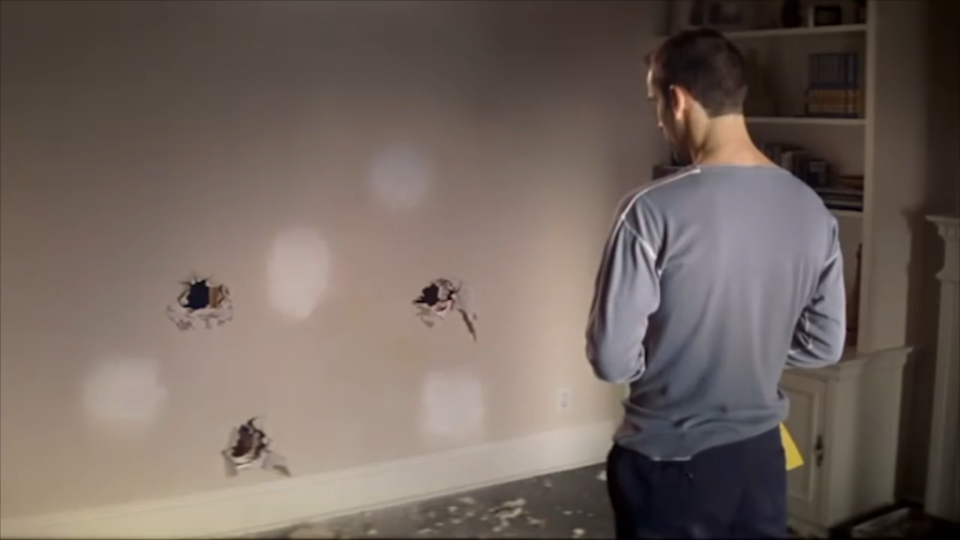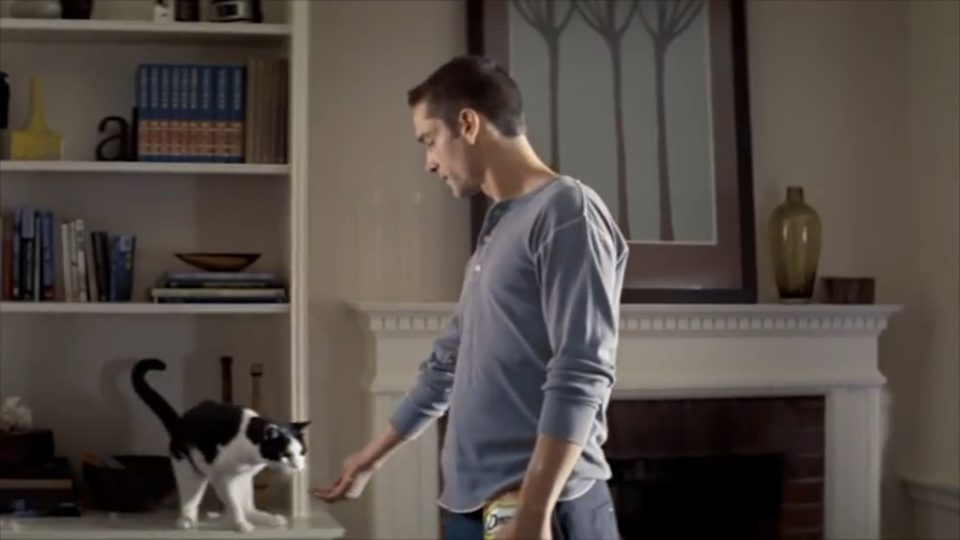Is my cat addicted to pet treats?

Poppy can be a rather stand-offish cat. She doesn’t sit on laps, she hates to be picked up to the point of anxiety. She will sometimes fix me with a curious, pensive gaze, as though trying to work out what I’m actually for. And then she remembers, and insinuates herself lithely between my ankles, and finds her voice, the high-pitched, insistent miaow she only ever deploys when she wants one thing: Dreamies.
For the benefit of non-cat people, Dreamies are packets of biscuity treats. Poppy is an absolute fiend for them. When anyone in the house relents and places a small clutch of them near the cats’ food bowls in the kitchen, she will – on first glance, rather sweetly – look round and wait until our other cat Maurice comes running in. But I suspect it isn’t just feline comradeship; she’s merely seeing which of the two piles could possibly be slightly bigger so she can elbow Maurice out of the way for it.
You may have seen the TV ads for Dreamies, in which a cat owner shakes the bag of treats and the pets come running. This is not an exaggeration. A Dreamie-addicted cat can not only hear the rustling of a Dreamie pack from three streets away, they can distinguish between that and the – to the untutored human ear – identical crinkling of, say, a packet of microwave rice or a bag of Maltesers.
Was it just our cats? I took to Twitter to find out, and was deluged with replies. “Yes. To the point where he won't even chew them, just swallows them whole and screams for the next one. Our Dreamies bag is covered in holes from where he's got his claws into it and has held on for dear life,” said Kat Wheeler. “Yes! I have to just touch the packet and our cat will appear from nowhere,” replied Jessica Gale. “Yes. The rustle of the packet is enough to summon them back from wherever they are hanging out beyond the garden,” said Jemima Lang. And so it went on, with more than one people referring to Dreamies as “cat crack” – their pets just went crazy for them.
Dreamies come in several flavours, chicken, turkey, duck, fish, beef, even cheese. They recently introduced a catnip flavour, and reader, I have not witnessed such scenes since I saw the Chemical Brothers in the Glastonbury Dance Tent in 1999. After sampling the wares, both cats tear-arsed around the house like extras in a Roadrunner cartoon before collapsing, their eyes like hubcaps, up against the radiators for a nine-hour chill-out session.

So… what’s in Dreamies? And are they really addictive? According to the back of the packet: “Surprisingly, we don’t use a secret ingredient or magic to make them this delicious.” The ingredients list on the Scrumptious Salmon flavour includes, “cereals, oils and fats, derivatives of vegetable origin, meat and animal derivatives, fish and fish derivatives (including 4 per cent salmon), minerals, vegetable protein extracts.”
“Dreamies products do not contain any addictive substances,” says Laurence Hooper, the UK portfolio director at Mars Petcare UK, which manufactures Dreamies. He adds: “The team at Dreamies has worked hard to pinpoint the textures and flavours that cats love. Our products come in a range of tempting flavours and are created with responsible treating in mind. They’re high quality and delicious, with added vitamins and minerals, no artificial flavours and less than two calories per treat.”
In lockdown people have been spending more time with their animals and that means the pets are just crying at us more for treats during the day
I had been hoping to speak to someone at Mars Petcare UK directly, and after a few days of emailing their PR department, I was allowed to send in some questions. The answers went through a few rounds of approval at executive level, I understand, and before I received them back I was asked what tone I’d be taking in the piece. I replied that it would be fairly light in tone – as my pieces generally are – but factual, as well. That might have informed the tone of the replies. So if you are in any way averse to cat owners being referred to throughout as “pet parents”, and the animals themselves as “furry friends”, then apologies in advance.
If you’re a cat owner of some vintage, you might think that Dreamies and other cat treats are a relatively recent phenomenon, and you’d be right. Dreamies in their current incarnation were relaunched with their colourful packets and cartoon cat branding about six years ago.
According to a piece in the food industry magazine, The Grocer, in January 2016, the cat treats market was far behind dog treats in terms of sales. Quoting a Kantar survey from the previous summer, The Grocer reported that the cat treats sector – including all drinks, treats and non main-food goods – was worth around £157m and fewer than half of cat owners bought treats for their pets in every 12 week period.

That had changed dramatically by the time The Grocer did a pet food analysis special in September this year. Cat treat sales alone had leapt by £20 million in a single year – a rise of 13.4 per cent year on year. So in the past six years we have been feeding our cats a lot of treats, and a lot of that impetus came from the Dreamies rebranding, and the planting of the seed that our cats deserve treats. Was the relaunch of Dreamies a specific attempt to bring the cat treats market up to the level of dog treats sales?
Hooper says: “At Dreamies, we know that there’s nothing quite like a shared moment with your cat and our goal has always been to create a brighter world for cats and cat owners. In the UK, cat treats are bought by fewer households than dog treats, primarily because cat owners do not think about the benefits of treating their cats as much as dog owners do. So, in 2016 we decided it was time to start conversations about the benefits of treating cats and inspire little moments of fun between pet parents and their cats.
“Our products offer pet parents fun and responsible ways to create moments of connection and enjoyment with their cats. Since then, the cat care and treats category has continued to grow and we have seen this accelerate more during the Covid pandemic, when more time spent with pets led to more treating moments.”

Which accounts for the rise in sales. With more of us working from home over the past year and a half, we’ve been spending more time with our cats. Or should that be, spending more time in service to our cats.
“Cats are unbelievably effective at annoying us into submission,” says vet and TV pet expert Dr Scott Miller, who regularly appears on ITV’s This Morning. “My cats will miaow their heads off to get what they want and sadly we’re all fallible human beings and we give in to them. So cats are excellent at training us to give them what they want.
“Treats are a way for us to ingratiate ourselves with our cats. They are the boss of the house after all and they see us as staff basically, so they’re more than happy for the staff to get them something tasty to eat.
So basically, you desperate, pathetic creature, you have been conditioned by both your cat and the pet food industry to buy your cat’s love
“In lockdown people have been spending more time with their animals and that means the pets are just crying at us more for treats during the day when otherwise they might have been waiting for someone to come home from work. And that becomes a self-fulfilling prophecy because if you’re working at home and maybe on a Zoom call or something the cat will be crying at you and you’ll give them some treats to stop them bugging you so you can concentrate on work.”
There’s a certain mythology built up around cats, which Dr Scott touches on there. Dogs are our faithful companions, man’s best friend, who will happily chase a ball all day and curl up at your feet like a big, soft lump of fluff. Cats have the cool disdain of Mae West and the silent, acerbic wit of Dorothy Parker, and allow us to live with them under sufferance. We have been taught to be grateful for their attention. Very often in our house there will be some plaintive, increasingly desperate “Dreamies for cuddles” bargaining going on. Poppy and Maurice always get Dreamies. Nobody ever gets a cuddle.
“Pet lovers know that cats can be fussy when it comes to showing their affection, but the power of Dreamies is that they are so tasty that cats can’t wait to enjoy the next one,” says Hooper in response to my question about how successful the Dreamies relaunch was considered. “This truth led to a fascinating observation, that by shaking the pack pet parents discovered they could win over feline affections. The irresistibility of Dreamies helped our pet parents create deeper connections with their furry friends and this has led to Dreamies becoming a staple in homes across the UK.
“At Dreamies we’re proud of the leading role we’ve had in working with pet parents to shine a spotlight on the benefits of treating cats and helping them create moments of connection. Our aim has always been to share the story of cat owners and we’ve continued to use innovative methods to bring these to life, such as through social media platforms which have allowed pet parents to post their own moments where ‘All It Takes Is A Shake’.”

So basically, you desperate, pathetic creature, you have been conditioned by your cat and the pet food industry to buy your cat’s love. That All It Takes Is A Shake slogan is perhaps one of the truest, most honest advertising campaigns ever made. But don’t think your cat is dancing to your tune when you shake that bag of Dreamies and they come running; you are finally fulfilling your only useful purpose of the day.
So as a marketing campaign, Dreamies is an extremely successful and profitable one, and the brand’s relaunch six years ago has revitalised and hugely boosted what was a fairly moribund market. However, are they any good for your cat?
The back of the Dreamies packet suggests a cat get no more than 20 individual treats in a day, and to reduce the cat’s main meals accordingly. The nutritional information says that at 408 kcals per 100g, a bag of Dreamies contains 244 calories. An average cat’s calorie intake should be about 200 calories a day, so 20 Dreamies would be about a fifth of that… if you stick to the recommended amount.
Dreamies also contain 22 per cent protein, nine per cent inorganic matter, and 22 per cent fat. It’s the last bit that worries Dr Miller when it comes to us treating our cats.
So while there is no secret ingredient or magic in Dreamies, there might well be something in the ‘cat crack’ jokes… the crack in this case being fat. And while it may be natural for cats to be attracted to fatty foods, it’s not doing them any good
“The problem with Dreamies is they’re really high in fat. Cats are what we call obligate carnivores [very high meat content, do not normally digest vegetables well] and as a result have a higher level of fat content in their diets than dogs do because dogs are more likely to eat a mixture of plant and animal materials.
“The cat’s ability to consume fat and process and metabolise it is faster than that of a dog, so they are drawn to it and cats love ice cream, and butter and all these things that have a high fat content, so they are very drawn to Dreamies.”
Aha, so while there is no secret ingredient or magic in Dreamies, there might well be something in the “cat crack” jokes… the crack in this case being fat. And while it may be natural for cats to be attracted to fatty foods, it’s not doing them any good.
Dr Scott says: “We have massive issues with overweight animals in the UK and it never seems to get much better. Treats are definitely going to drive that.”
So what can be done? Well, moderation in all things, says Anna Ewers Clark, veterinary research and standards lead at national pet charity Blue Cross. She says: “Going through a day without any treats at all is a challenge for anyone, and treats can be really great for your cat to get that bit of excitement, a bit of entertainment. You can use them as part of a game or even as part of a cat’s training – you can use them to give your cat a bit of exercise, in the right way as they will forage for treats and work harder for them than they might do for their normal food.

“But it’s always a case of good things in moderation. If a person only eats treats and chocolate biscuits all day long it can not only cause them to put on weight but we’re also not getting the balance of nutrients that we need and that’s true for cats as well. Certainly, if you’ve got a cat that is struggling with its weight then treats might be something you have to cut down on, because if they’re eating too many treats they won’t be getting the correct balance of nutrients.”
That is true for Poppy especially. She will happily walk past a bowl of food and sit by them, miaowing loudly and staring at the Dreamies packets on the worktop. And we should not be giving in so easily.
“If the cat is encouraging its owner to feed them treats, and they’re eating more and more treats then they’re less likely to eat their food, which is a complete balanced diet,” says Scott. “In this case it’s kind of like McDonald’s for cats… it’s fine to have it now and again, but if you are eating it all the time at the expense of balanced meals, then that’s going to be a problem.
“A good rule of thumb is that a lot of people think of their cats as furry children, but would you let your actual child ask you for a Mars bar every five seconds and you’d answer, sure, have one, have another. You’d say, you can have one, and that’s it for today.
“Cats work on us by annoying us into submission but as pet parents we need to take the view that is this the right thing or is this the easy thing, and I think quite clearly with cat treats it’s the second one.”
Mars Petcare didn’t so much fill a gap in the market with the massively successful relaunch of Dreamies, they pretty much created a new market, and the pet food shelves are full of treats from many companies. In a neat bit of synergetic branding, Mars Petcare also appealed directly to the LGBTQ+ cat-owning market with specially-branded packs and charitable donations.
Hooper says: “We’re also proud that in 2021, we were able to use the brand’s popularity to drive awareness and support for the mental health of the lesbian, gay, bisexual, trans and queer (LGBTQ+) community. The intersection between pet ownership among the LGBTQ+ community and the positive impact animals have on mental health makes Dreamies an ideal brand to step into this space and drive meaningful change. We partnered with the LGBT Foundation, making a financial contribution to support the charity’s helpline all year and proudly displayed the rainbow on our packaging and in communication, along with the helpline number. The response we received was overwhelmingly positive.”
Prior to 2016, our cats didn’t really know what they were missing with treats. Now, they’re a fundamental part of the pet owner’s life. It feels as though this is an evolution in feline development; cats must now have the love of Dreamies imprinted on their genetic code. The genie is out of the bottle, the cat is out of the bag. We have attempted to buy our cats’ affections, and we will never be set free of this contract.
And as I write this, Poppy is staring at me with an intensity that suggests only one thing: if I don’t know what she wants, then I must be quite as stupid as she thinks I am. Please excuse me, I must get back to my primary duties as cat staff.
Read More
All cats have ‘an element of psychopathy’, according to new study
Is getting a cat or dog bad for the planet?
The UK has a quarter of a million stray cats, new study says
Australian council may ban cats outside if they are not on leads


